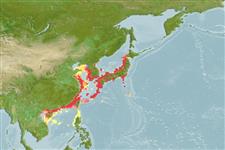Common names from other countries
>
Acropomatiformes (Oceanic basses) >
Lateolabracidae (Asian seaperches)
Etymology: Lateolabrax: Greek, latos, a fish of the Nile + Greek, labrax, -akos = a fish (Dicentrarchus labrax) (Ref. 45335).
More on author: Cuvier.
Issue
Junior synonym Lateolabrax maculatus considered as a valid species reported to be widely distributed (Japan, only in the Ariake Sea and off Nagasaki; China (off all coasts), Taiwan, and Korea (usually off the southern and western coasts) (Ref. 118669)
Environment: milieu / climate zone / depth range / distribution range
Οικολογία
Θαλασσινό(ά); Γλυκού νερού; Υφάλμυρο Υφαλόφιλο(α); κατάδρομος (Ref. 51243); εύρος βάθους 5 - ? m. Subtropical; 44°N - 15°N, 106°E - 143°E
Western Pacific: Japan to the South China Sea.
Length at first maturity / Μέγεθος / Βάρος / Age
Maturity: Lm ?, range 50 - ? cm
Max length : 102 cm TL αρσενικό/απροσδιόριστο; (Ref. 40637); common length : 16.1 cm SL αρσενικό/απροσδιόριστο; (Ref. 35840); μεγ. δημοσιευμένο βάρος: 8.7 kg (Ref. 40637)
Ραχιαίες άκανθες (συνολικά): 12 - 15; Μαλακές ραχιαίες ακτίνες (συνολικά): 12-14; Εδρικές άκανθες 3; Μαλακές εδρικές ακτίνες: 7 - 9
Found in moving water of inshore rocky reefs. Juveniles may ascend rivers and return to sea to spawn. Protandrous, sex change happens after maturation at age 2 (Ref. 36558). Spawning occurs during winter, in deeper rocky reefs or inshore areas. Predaceous, feeding on zooplankton at an early age and on small fish and shrimps as adults (Ref. 12497). Utilized as a food fish (Ref. 559). Family placement uncertain (Ref. 1830). Used in Chinese medicine (Ref. 12166).
Males mature at age 2 years, becoming females when older (Ref. 36558). Juveniles may ascend rivers migrating to the sea to spawn (Ref. 36558).
Paxton, J.R., D.F. Hoese, G.R. Allen and J.E. Hanley, 1989. Pisces. Petromyzontidae to Carangidae. Zoological Catalogue of Australia, Vol. 7. Australian Government Publishing Service, Canberra, 665 p. (Ref. 7300)
IUCN Red List Status (Ref. 130435)
CITES (Ref. 128078)
Not Evaluated
Threat to humans
Harmless
Human uses
αλιεία: Εμπορικό(ά); Υδατοκαλλιέργειες: Εμπορικό(ά); αλιεία αναψυχής: ναί
Περισσότερες πληροφορίες
ΣυνεργάτεςΦωτογραφίεςStamps, Coins Misc.ΉχοιΣιγκουατέραΤαχύτηταΚολυμβητικός ΤύποςΕπιφάνεια βραγχίωνOtolithsΕγκέφαλοιΌραση
Εργαλεία
Special reports
Download XML
Διαδικτυακές πηγές
Estimates based on models
Preferred temperature (Ref.
115969): 12.7 - 26.3, mean 22.4 (based on 180 cells).
Phylogenetic diversity index (Ref.
82804): PD
50 = 1.0000 [Uniqueness, from 0.5 = low to 2.0 = high].
Bayesian length-weight: a=0.01259 (0.00885 - 0.01792), b=3.02 (2.92 - 3.12), in cm Total Length, based on LWR estimates for this species (Ref.
93245).
Τροφικό Επίπεδο (Ref.
69278): 3.1 ±0.3 se; based on diet studies.
Ελαστικότητα (Ref.
120179): Μεσαίο(α), ελάχιστος χρόνος για διπλασιασμό πληθυσμού 1,4 - 4,4 έτη (K=0.14-0.2; tm=2; Fec=1,726,242).
Fishing Vulnerability (Ref.
59153): Moderate to high vulnerability (52 of 100).
Climate Vulnerability (Ref.
125649): Moderate to high vulnerability (54 of 100).
